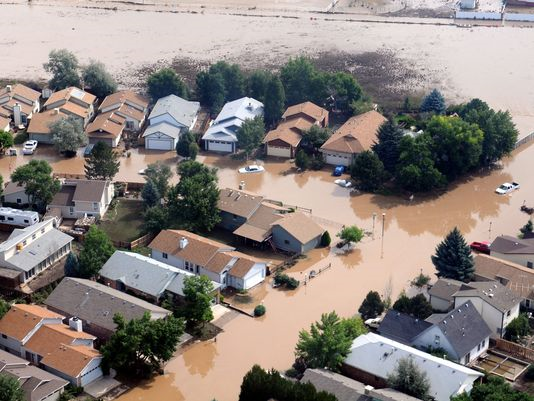Colorado’s ‘Biblical’ flood in line with climate trends – Over 1200 people missing – ‘This is clearly going to be a historic event. The true magnitude is really just becoming obvious now.’
By Andrew Freedman
13 September 2013 (Climate Central) – The Boulder, Colo. area is reeling after being inundated by record rainfall, with more than half a year’s worth of rain falling over the past three days. During those three days, 24-hour rainfall totals of between 8 and 10 inches across much of the Boulder area were enough to qualify this storm as a 1 in 1,000 year event, meaning that it has a 0.1 percent chance of occurring in a given year. At least four people have been confirmed dead so far with many more still missing, and thousands have been evacuated from their homes and businesses. All along Colorado’s Front Range from Denver northward to Boulder and in nearby areas, small creeks have been transformed into raging rivers, and surges of water, mud, and debris have blasted their way through canyons, at one point trapping a firefighter on a treetop before being rescued. Numerous longstanding records have been smashed, including the all-time 24-hour rainfall record in Boulder. “This is clearly going to be a historic event,” National Weather Service Director Louis Uccellini said in an interview. “The true magnitude is really just becoming obvious now.” Uccellini said the Weather Service has initiated a review of its performance leading up to and during the event. Although the potential for heavy rainfall was in the agency’s forecasts a week in advance, he said, “Clearly the magnitude of the rainfall and the repetivieness of it in some critical areas was not pinpointed” well ahead of time. Uccellini said that this event will be the new historical high water mark for many affected rivers and streams. In a technical discussion on Thursday, the NWS described the rainfall amounts as “biblical.” On average, Boulder gets about 1.7 inches of rain during September, based on the 1981-2010 average. So far this month, Boulder has received 12.3 inches of rain. This smashes the record for the wettest month ever in Boulder, which was set in May 1995 when 9.59 inches of precipitation fell — and September isn’t even half over! Not only that, but the average yearly rainfall in Boulder is 20.68 inches. This means that Boulder picked up well over half its annual precipitation in just a couple of days. This comes on the heels of a summer when Boulder experienced a moderate drought according to the U.S. Drought Monitor. This summer also featured the Colorado’s most destructive wildfire on record. […] It will take climate scientists many months to complete studies into whether manmade global warming made the Boulder flood more likely to occur, but the amount by which this event has exceeded past events suggests that manmade warming may have played some role by making the event worse than it would have otherwise been. Considering that this flood event occurred in the backyard of some of the world’s top climate researchers, it is likely that this event will be closely researched. Boulder is home to several major weather and climate research institutions, including the National Center for Atmospheric Research and the Earth System Research Laboratory, both of which were forced to close due to flooding. Extreme rainfall events have become more frequent across the U.S. during the past several decades in part due to manmade global warming. Increasing air and ocean temperatures mean that the air is generally carrying more water vapor than it used to, and this moisture can be tapped by storm systems to yield rain or snow extremes. Trends in extreme precipitation events vary by region, though, and in general the biggest increases have taken place in the Midwest and Northeast. However, most parts of the U.S. have seen an increase in extreme precipitation events, according to the draft National Climate Assessment report that was released this past January. The report goes on to note that in the future, “increases in the frequency and intensity of extreme precipitation events are projected for most U.S. areas.” [more]
Colorado’s “Biblical” Flood in Line with Climate Trends 
By Gary Stoller
15 September 2013 (USA TODAY) – The number of people unaccounted for in flood-ravaged Colorado rose Sunday to 1,254 as flooding spread to 15 counties and rain continued to fall. Many of those unaccounted for were reported unreachable on the phone by family members. “We don’t expect to find 1,254 fatalities,” said Micki Trost, a spokeswoman for the Colorado Division of Homeland Security and Emergency Management. Five fatalities — three in Boulder County, one in Larimer County and one in El Paso County — have been confirmed since the bulk of the rain began Wednesday evening. Still the number of fatalities could rise. An 80-year-old woman in Larimer County’s Cedar Grove was missing and presumed dead after her home was washed away by the flooding Big Thompson River, the county sheriff’s office said Sunday. The woman was injured and unable to leave her home Friday night, sheriff’s spokesman John Schulz said. A 60-year-old woman is also presumed dead after the river destroyed her home the same night. Some people just don’t know what’s come of their relatives. A Dallas man saw a photo of his mother’s Big Thompson Canyon home in ruins on a Denver TV website. “I don’t know that she’s even OK,” Rob Clements told The Coloradoan about his mother, Libby Orr, 73, with whom he last spoke on Thursday. “I presume she is. But her house, if not completely gone, fell into the river and is most of the way gone.” Many roads and bridges in the state are damaged or destroyed, said Amy Ford, a spokeswoman for the Colorado Department of Transportation. Crews are assessing the extent of the damage, which will cost “hundreds of millions” of dollars to repair, she said.
